Variation Characteristics of Nitrous Oxide Along the East Antarctic Coast
Abstract
1. Introduction
2. Materials and Methods
3. Results and Discussion
3.1. Interannual Variation in N2O Concentration
3.2. Seasonal and Monthly Variations in N2O Concentration
3.3. Comparison with Other Antarctic Observatories
4. Conclusions
Author Contributions
Funding
Data Availability Statement
Acknowledgments
Conflicts of Interest
References
- Ruiz, D.J.; Prather, M.J.; Strahan, S.E.; Thompson, R.L.; Froidevaux, L.; Steenrod, S.D. How atmospheric chemistry and transport drive surface variability of N2O and CFC-11. J. Geophys. Res. Atmos. 2021, 126, e2020JD033979. [Google Scholar] [CrossRef]
- Yang, R.; Yuan, L.J. Generation, emission reduction/utilization, and challenges of greenhouse gas nitrous oxide in wastewater treatment plants—A review. J. Water Process Eng. 2023, 53, 103871. [Google Scholar] [CrossRef]
- Lin, H. Research Status and Prospect of Marine Nitrous Oxide. Adv. Geosci. 2014, 4, 115–121. [Google Scholar] [CrossRef]
- Khalil, M.A.K.; Rasmussen, R.A.; Shearer, M.J. Atmospheric nitrous oxide: Patterns of global change during recent decades and centuries. Chemosphere 2002, 47, 807–821. [Google Scholar] [CrossRef]
- Stocker, T.F. Climate Change 2013: The Physical Science Basis: Working Group I Contribution to the Fifth Assessment Report of the Intergovernmental Panel on Climate Change; Cambridge University Press: Cambridge, UK; New York, NY, USA, 2014; p. 1535. Available online: https://www.ipcc.ch/report/ar5/wg1/ (accessed on 24 April 2025).
- Graves, C.J.; Makrides, E.J.; Schmidt, V.T.; Giblin, A.; Cardon, Z.; Rand, D. Functional responses of salt marsh microbial communities to long-term nutrient enrichment. Appl. Environ. Microbiol. 2016, 82, 2862–2871. [Google Scholar] [CrossRef]
- Smith, K.A. Changing views of nitrous oxide emissions from agricultural soil: Key controlling processes and assessment at different spatial scales. Eur. J. Soil. Sci. 2017, 68, 137–155. [Google Scholar] [CrossRef]
- Thompson, R.L.; Lassaletta, L.; Patra, P.K.; Wilson, C.; Wells, K.C.; Gressent, A.; Koffi, E.N.; Chipperfield, M.P.; Winiwarter, W.; Davidson, E.A.; et al. Acceleration of global N2O emissions seen from two decades of atmospheric inversion. Nat. Clim. Chang. 2019, 9, 993–998. [Google Scholar] [CrossRef]
- Ravishankara, A.R.; Aniel, J.S.; Portmann, R.W. Nitrous oxide(N2O): The dominant ozone-depleting substance emitted in the 21st century. Science 2009, 326, 123–125. [Google Scholar] [CrossRef]
- Chen, L.Q.; Zhan, L.Y.; Xu, S.Q.; Zhang, J.; Zhang, Y. Multiple processes affecting surface seawater N2O saturation anomalies in tropical oceans and Prydz Bay, Antarctica. Adv. Polar Sci. 2012, 23, 87–94. [Google Scholar] [CrossRef]
- Zhan, L.Y.; Chen, L.Q. Distributions of N2O and its air-sea fluxes in seawater along cruise tracks between 30°S–67°S and in Pryde Bay, Antarctica. J. Geophrsical Res. 2009, 114, C03019. [Google Scholar] [CrossRef]
- Zhan, L.Y.; Chen, L.Q.; Zhang, J.X. Contribution of upwelling to air-sea N2O flux at the tip of the Antarctica Peninsula. J. Limnol. Oceanogr. 2018, 63, 2737–2750. [Google Scholar] [CrossRef]
- Zhan, L.Y.; Chen, L.Q.; Zhang, J.X.; Yan, J.P.; Li, Y.H.; Wu, M. Austral summer N2O sink and source characteristics and their impact factors in Prydz Bay, Antarctica. J. Geophys. Res. Oceans. 2015, 120, 5836–5849. [Google Scholar] [CrossRef]
- Zhu, R.B.; Liu, Y.S.; Hua, X.U.; Ma, J.; Sun, L.G. Temporal and spatial variations of δ15N and δ18O for atmospheric N2O above the oceanic surface from Shanghai to Antarctica. Sci. China Ser. D Earth Sci. 2008, 51, 899–910. [Google Scholar] [CrossRef]
- Liu, Y.S.; Zhu, R.B.; Ma, D.; Xu, H.; Luo, Y.H.; Huang, T. Temporal and spatial variations of nitrous oxide fluxes from the littoral zones of three alga-rich lakes in coastal Antarctica. Atmos. Environ. 2011, 45, 1464–1475. [Google Scholar] [CrossRef]
- Zhu, R.B.; Liu, Y.; Ma, E.; Sun, J.; Hua, X.; Sun, L. Greenhouse gas emissions from penguin guanos and ornithogenic soils in coastal Antarctica: Effects of freezing–thawing cycles. Atmos. Environ. 2009, 43, 2336–2347. [Google Scholar] [CrossRef]
- Hayashi, K.; Tanabe, Y.; Ono, K.; Loonen, M.J.J.E.; Asano, M.; Fujitani, H.; Tokida, T.; Uchida, M.; Hayatsu, M. Seabird-affected taluses are denitrification hotspots and potential N2O emitters in the High Arctic. Sci. Rep. 2018, 8, 17261. [Google Scholar] [CrossRef]
- Stewart, K.J.; Brummell Farrell, R.E.; Siciliano, S.D. N2O flux from plant-soil systems in polar deserts switch between sources and sinks under different light conditions. Soil. Biol. Biochem. 2012, 48, 69–77. [Google Scholar] [CrossRef]
- Li, F.; Zhu, R.B.; Bao, T.; Wang, Q.; Xu, H. Sunlight stimulates methane uptake and nitrous oxide emission from the High Arctic tundra. Sci. Total Environ. 2016, 572, 1150–1160. [Google Scholar] [CrossRef]
- Bao, T.; Zhu, R.B.; Wang, P.; Ye, W.J.; Ma, D.W.; Xu, H. Potential effects of ultraviolet radiation reduction on tundra nitrous oxide and methane fluxes in maritime Antarctica. Sci. Rep. 2018, 8, 3716. [Google Scholar] [CrossRef]
- Bao, T.; Zhu, R.B.; Ye, W.J.; Xu, H. Effects of sunlight on tundra nitrous oxide and methane fluxes in maritime antarctica. Adv. Polar Sci. 2020, 31, 178–191. [Google Scholar] [CrossRef]
- Bian, L.G.; Gao, Z.Q.; Sun, Y.L.; Ding, M.H.; Tang, J.; Schnell, R.C. CH4 Monitoring and Background Concentration at Zhongshan Station, Antarctica. Atmos. Clim. Sci. 2016, 6, 135–144. [Google Scholar] [CrossRef]
- Ye, W.J.; Bian, L.G.; Wang, C.; Zhu, R.; Zheng, X.; Ding, M. Monitoring atmospheric nitrous oxide background concentrations at Zhongshan Station, east Antarctica. J. Environ. Sci. 2016, 47, 193–200. [Google Scholar] [CrossRef] [PubMed]
- Pan, J.J.; Fang, S.X.; Wang, H.Y. Research on the working standards calibration method for measuring atmospheric nitrous oxide concentration. Acta Sci. Circumstantiae 2018, 38, 1768–1773. [Google Scholar] [CrossRef]
- Fang, S.X.; Zhou, L.X.; Zhang, F. Dual channel GC system for measuring background atmospheric CH4, CO, N2O and SF6. Acta Sci. Circumstantiae 2010, 30, 52–59. [Google Scholar] [CrossRef]
- Lan, X.; Mund, J.W.; Crotwell, A.M.; Thoning, K.W.; Moglia, E.; Madronich, M.; Baugh, K.; Petron, G.; Crotwell, M.J.; Neff, D.; et al. Atmospheric Nitrous Oxide Dry Air Mole Fractions from the NOAA GML Carbon Cycle Cooperative Global Air Sampling Network, 1997–2024, Version: 2025-04-26, 2025.
- Luís, A.; Laura, I.V.; Holz Celina, F.; Paulo, R.; Diogo, M.; Duncan, P.F.; Adélio, M. A comprehensive review of NOx and N2O mitigation from industrial streams. Renew. Sustain. Energy Rev. 2022, 155, 111916. [Google Scholar] [CrossRef]
- Nevison, C.D.; Dlugokencky, E.; Dutton, G.; Elkins, J.W.; Fraser, P.; Hall, B.; Krummel, P.B.; Langenfelds, R.L.; O’Doherty, S.; Prinn, R.G.; et al. Exploring causes of interannual variability in the seasonal cycles of tropospheric nitrous oxide. J. Atmos. Chem. Phys. 2011, 11, 3713–3730. [Google Scholar] [CrossRef]
- Thompson, R.L.; Chevallier, F.; Crotwell, A.M.; Dutton, G.; Langenfelds, R.L.; Prinn, R.G.; Weiss, R.F.; Tohjima, Y.; Nakazawa, T.; Krummel, P.B.; et al. Nitrous oxide emissions 1999 to 2009 from a global atmospheric inversion. Atoms. Chem. Phys. 2014, 14, 1801–1817. [Google Scholar] [CrossRef]
- Mckenzie, J.D.; Cassano, J.J.; Jozef, G.C.; Seefeldt, M. Variations in boundary layer stability across Antarctica: A comparison between coastal and interior sites. Weather. Clim. Dynam. 2023, 4, 1045–1069. [Google Scholar] [CrossRef]
- Ishijima, K.; Patra, P.K.; Takigawa, M.; Machida, T.; Matsueda, H.; Sawa, Y.; Steele, L.P.; Krummel, P.B.; Langenfelds, R.L.; Aoki, S.; et al. Stratospheric influence on the seasonal cycle of nitrous oxide in the troposphere as deduced from aircraft observations and model simulations. J. Geophys. Res. Atmos. 2010, 115, D20308. [Google Scholar] [CrossRef]
- Stohl, A.; Sodemann, H. Characteristics of atmospheric transport into the Antarctic troposphere. J. Geophys. Res. 2010, 115, D02305. [Google Scholar] [CrossRef]
- Gonzalez, Y.; Commane, R.; Manninen, E.; Daube, B.C.; Schiferl, L.D.; McManus, J.B.; McKain, K.; Hintsa, E.J.; Elkins, J.W.; Montzka, S.A.; et al. Impact of stratospheric air and surface emissions on tropospheric nitrous oxide during Atom. Atmos. Chem. Phys. 2021, 21, 11113–11132. [Google Scholar] [CrossRef]
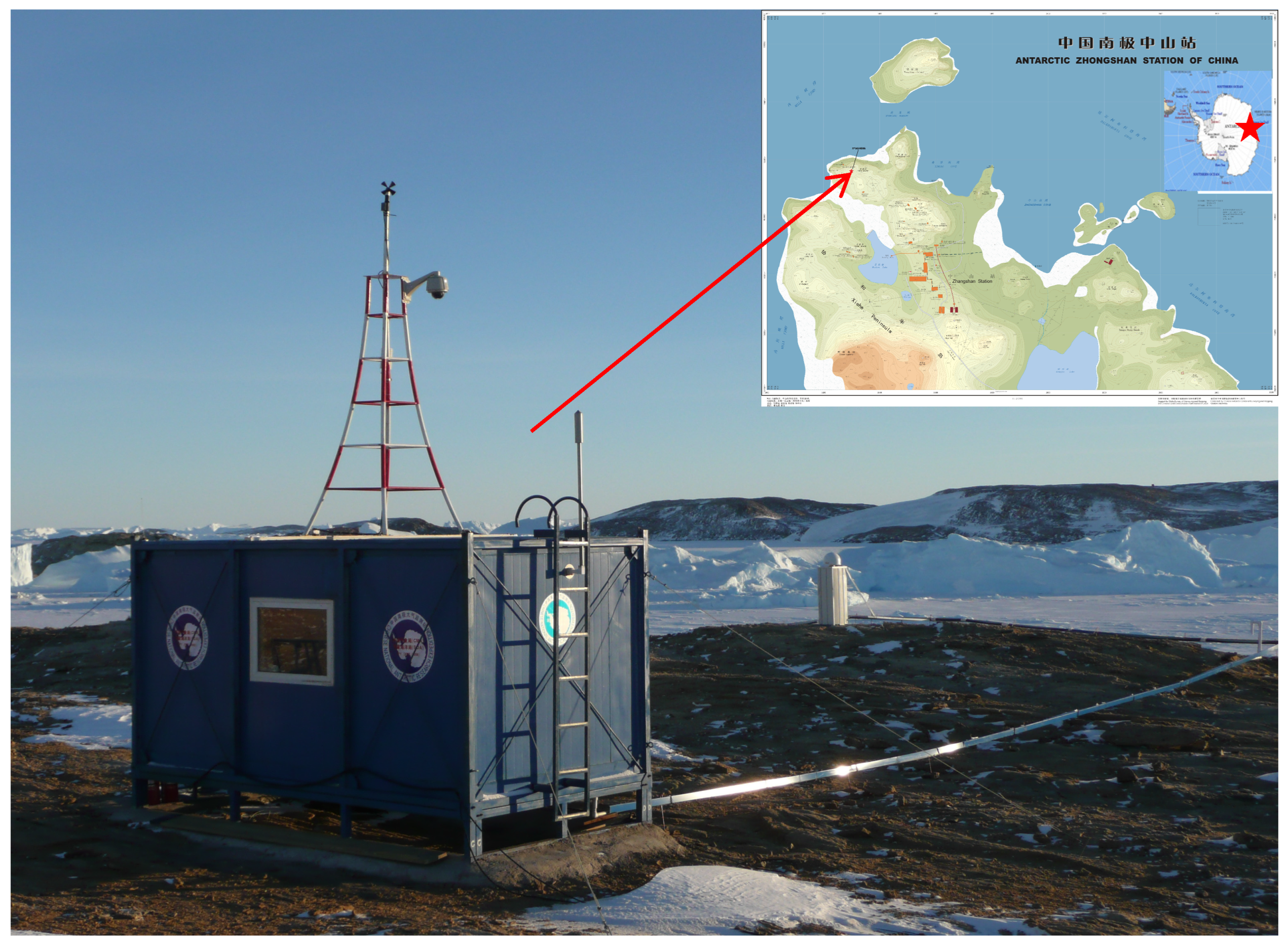
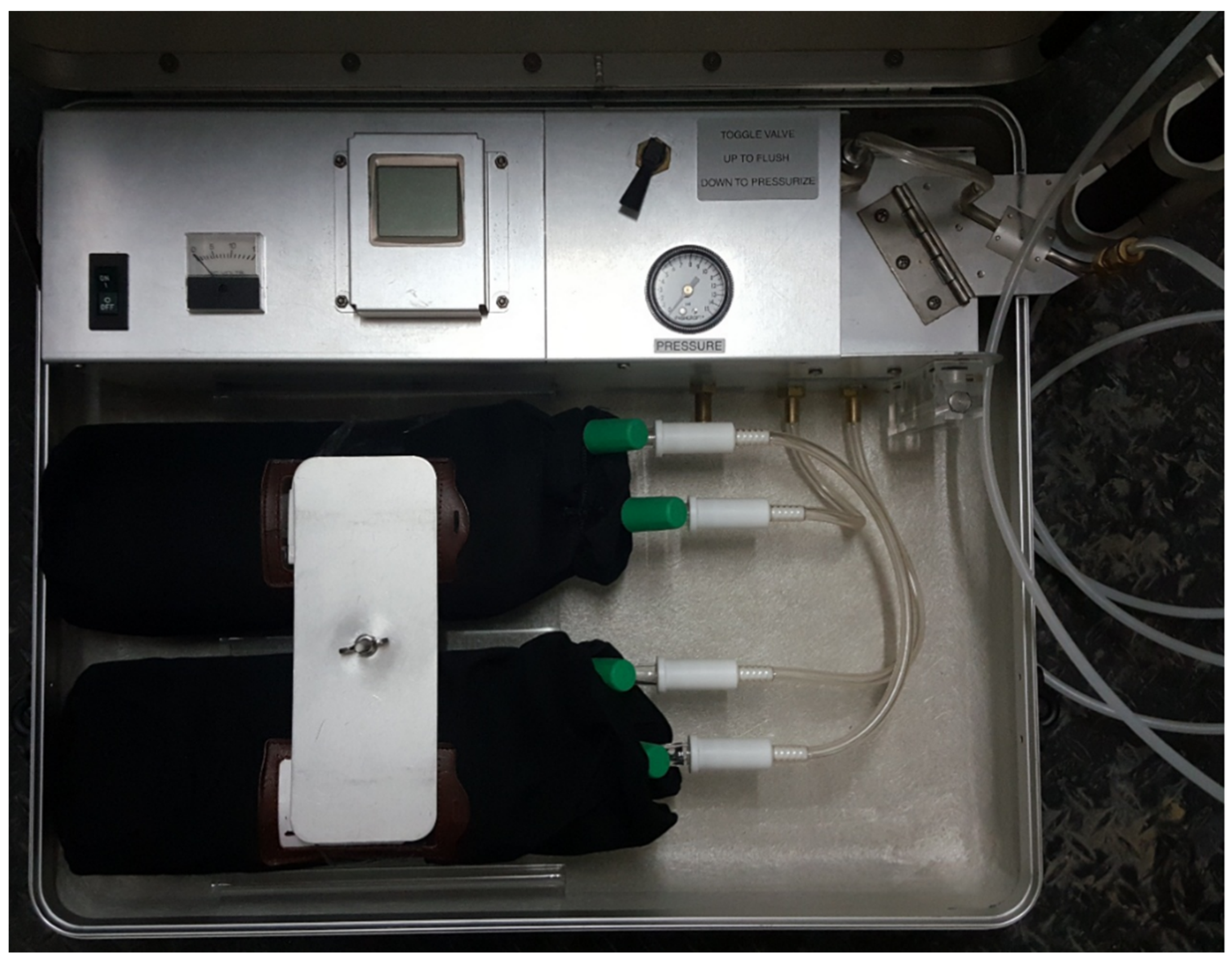
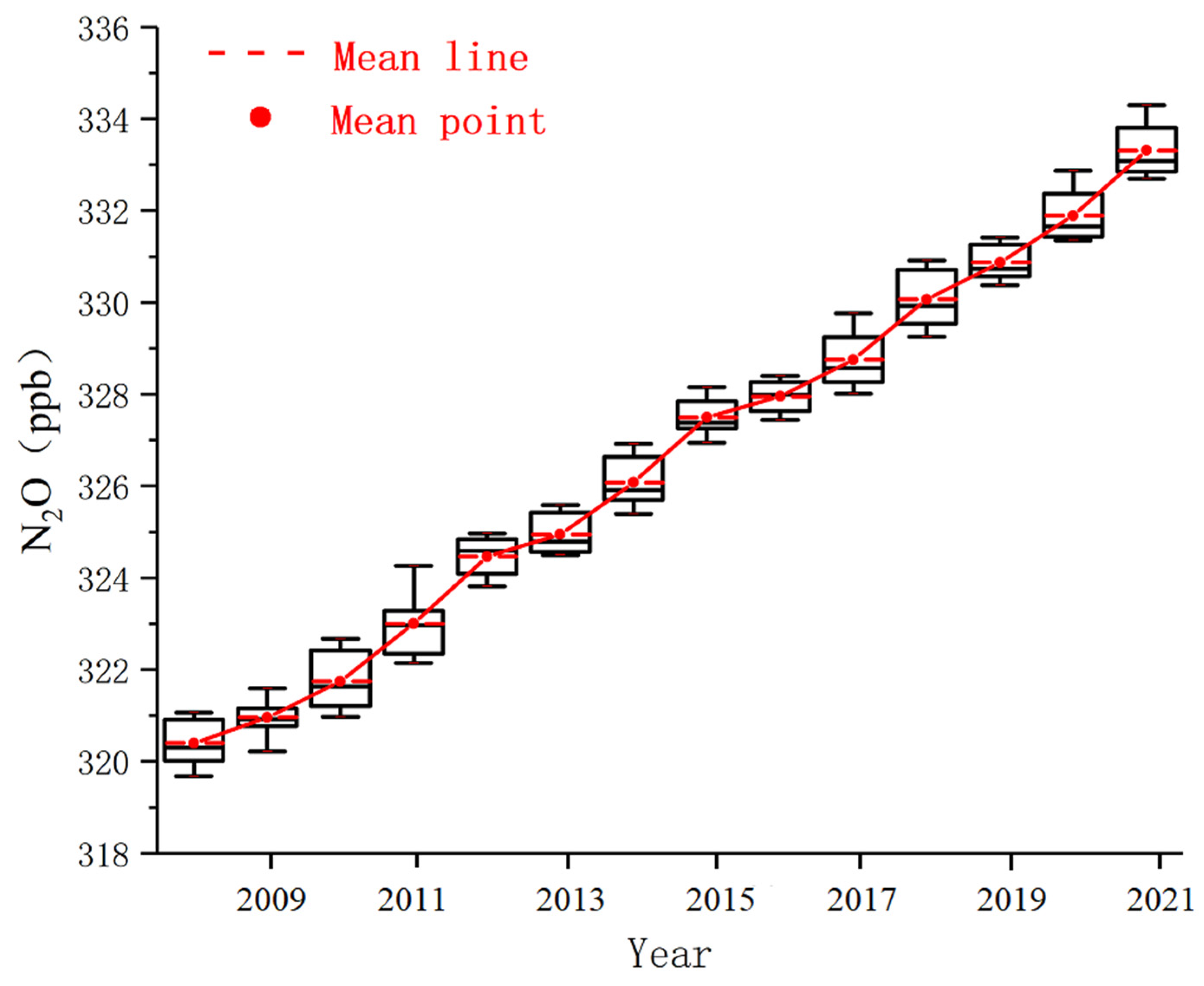

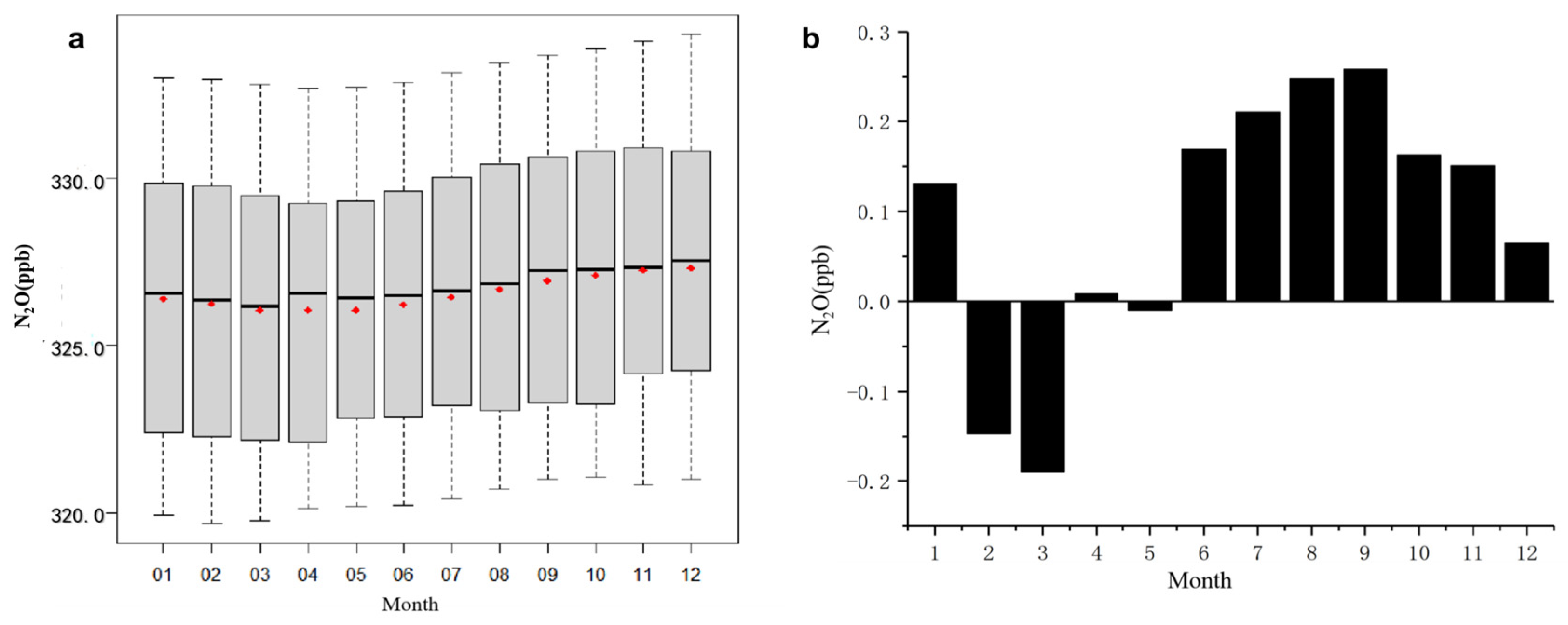
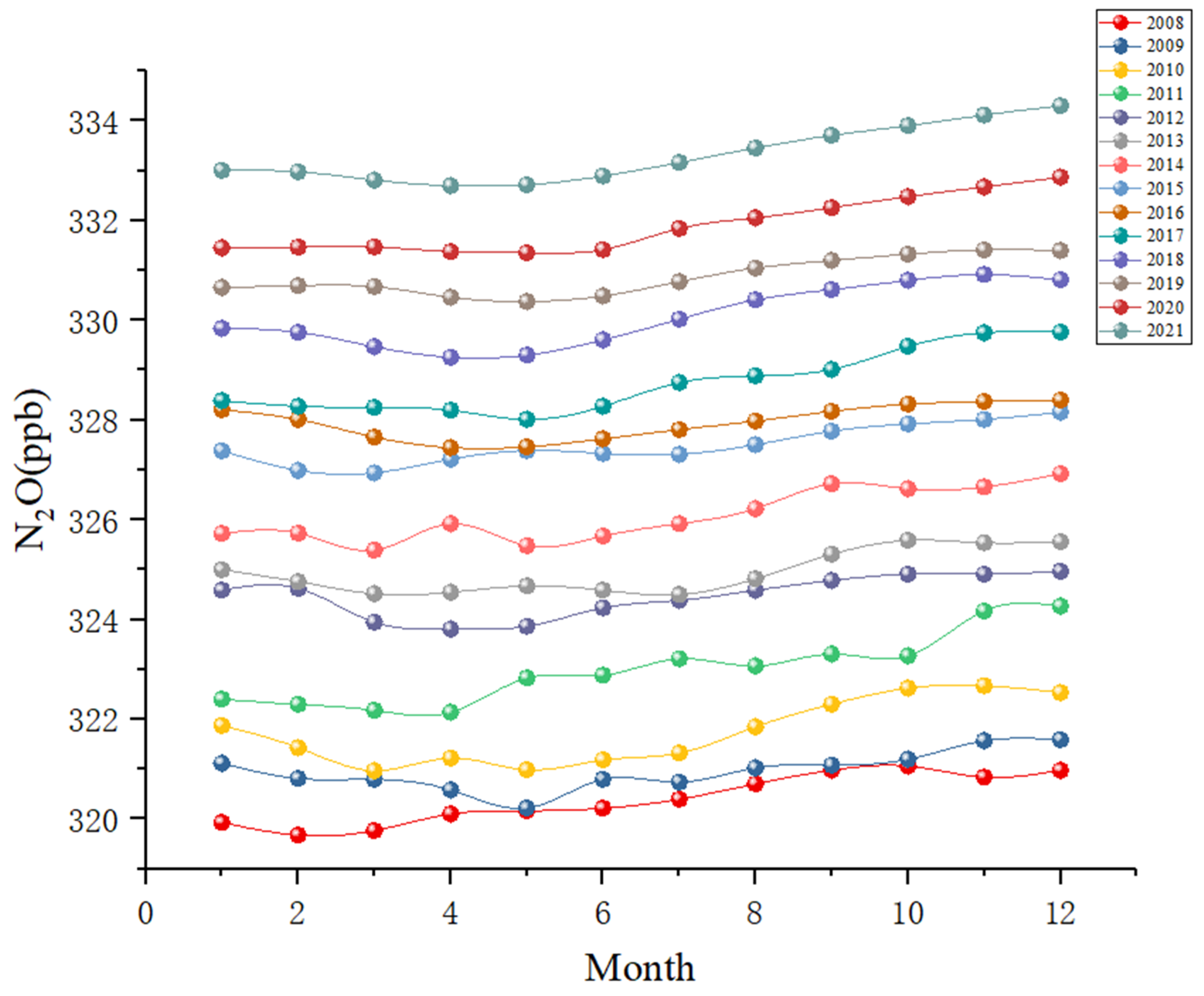
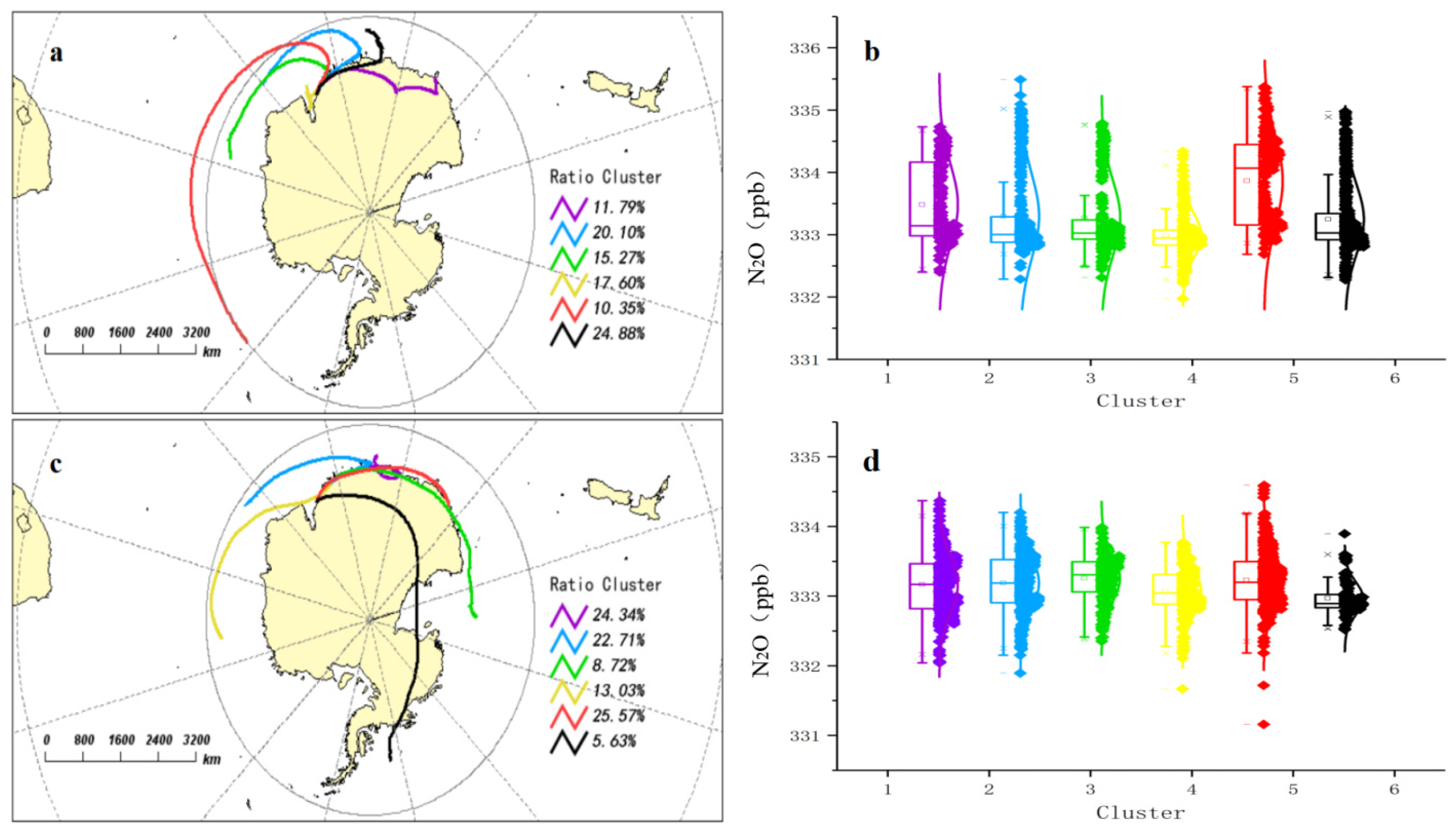
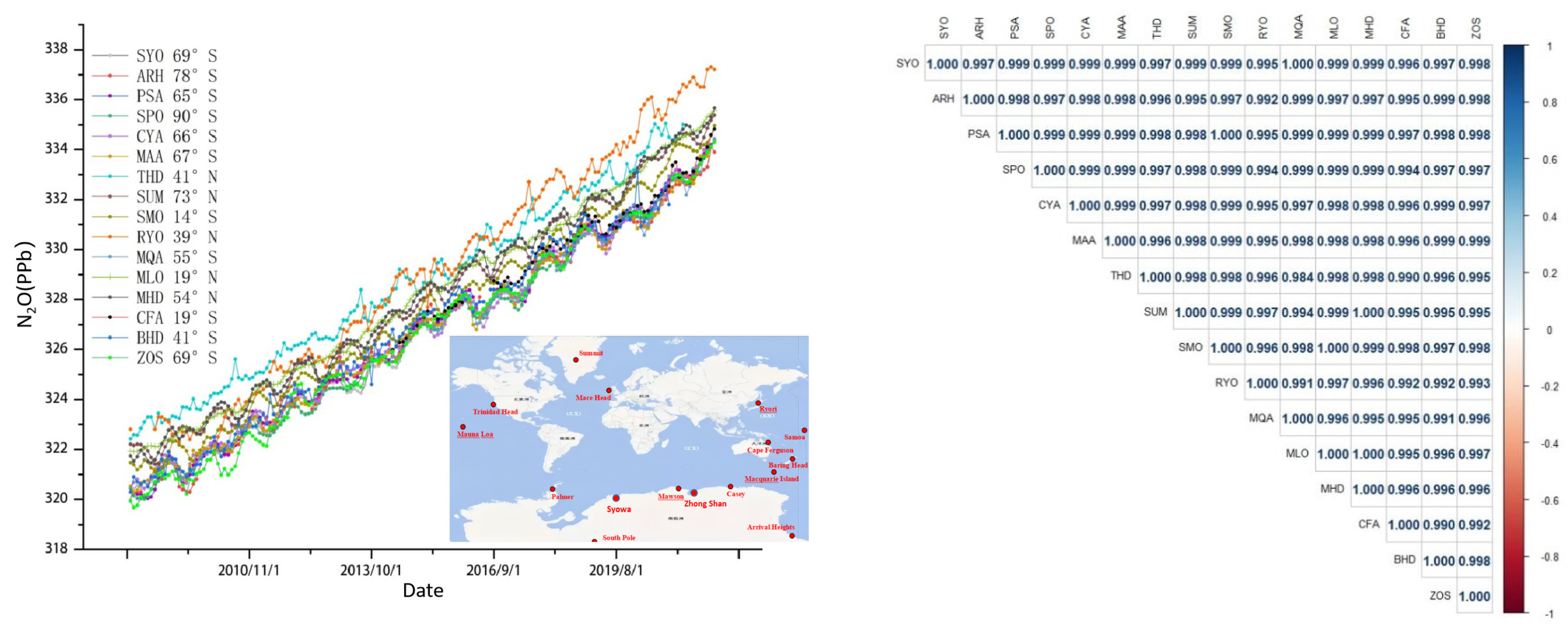
| ZOS | CYA | MAA | SPO | SPO (Insite) | PSA | ARH | SYO | |
|---|---|---|---|---|---|---|---|---|
| Average annual growth rate/ppb | 0.99 | 0.95 | 0.95 | 0.98 | 1.00 | 0.99 | 0.96 | 0.97 |
Disclaimer/Publisher’s Note: The statements, opinions and data contained in all publications are solely those of the individual author(s) and contributor(s) and not of MDPI and/or the editor(s). MDPI and/or the editor(s) disclaim responsibility for any injury to people or property resulting from any ideas, methods, instructions or products referred to in the content. |
© 2025 by the authors. Licensee MDPI, Basel, Switzerland. This article is an open access article distributed under the terms and conditions of the Creative Commons Attribution (CC BY) license (https://creativecommons.org/licenses/by/4.0/).
Share and Cite
Xu, Y.; Tian, B.; Tang, J.; Bian, L.; Ding, M.; Sun, W.; Xu, X.; Zhang, D. Variation Characteristics of Nitrous Oxide Along the East Antarctic Coast. J. Mar. Sci. Eng. 2025, 13, 1040. https://doi.org/10.3390/jmse13061040
Xu Y, Tian B, Tang J, Bian L, Ding M, Sun W, Xu X, Zhang D. Variation Characteristics of Nitrous Oxide Along the East Antarctic Coast. Journal of Marine Science and Engineering. 2025; 13(6):1040. https://doi.org/10.3390/jmse13061040
Chicago/Turabian StyleXu, Yongnian, Biao Tian, Jie Tang, Lingen Bian, Minghu Ding, Wanqi Sun, Xiuli Xu, and Dongqi Zhang. 2025. "Variation Characteristics of Nitrous Oxide Along the East Antarctic Coast" Journal of Marine Science and Engineering 13, no. 6: 1040. https://doi.org/10.3390/jmse13061040
APA StyleXu, Y., Tian, B., Tang, J., Bian, L., Ding, M., Sun, W., Xu, X., & Zhang, D. (2025). Variation Characteristics of Nitrous Oxide Along the East Antarctic Coast. Journal of Marine Science and Engineering, 13(6), 1040. https://doi.org/10.3390/jmse13061040





